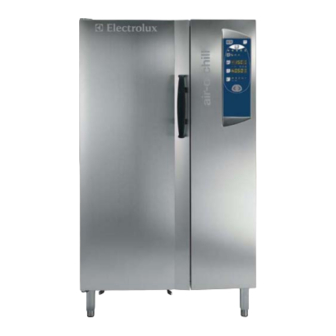Electrolux AOFP201RU Manuel - Sayfa 4
Dondurucu Electrolux AOFP201RU için çevrimiçi göz atın veya pdf Manuel indirin. Electrolux AOFP201RU 11 sayfaları. Bcf 30kg 6 gn1/1 lw (240/3/60hz), bcf 50kg 10 gn1/1 lw (240/3/60hz) / bcf 100kg 20 gn1/1 lw (240/3/60hz) / bcf 70kg 10 gn2/1 lw (240/3/60hz) / bcf 180kg 20 gn2/1 lw (240/3/60hz) / bcf 30kg 6 gn1/1 lw (208/3/60hz) / bcf 50kg 10 gn1/1 lw (208/3/60hz) / bcf
Ayrıca Electrolux AOFP201RU için: Kullanım ve Bakım Talimatları Kılavuzu (27 sayfalar)

4 - AOFP201RU blast freezers (for use with remote unit)
External dimensions:
Width
Depth with door closed
Depth with door open
Height
Cell dimensions:
Width
Depth
Height
Productivity (according to specifications) (*):
Minutes
Pounds
PANS:
20" x 25" x 2 1/2"
530mm x 650mm x 65mm.
Number of pans
18" x 26"
457.2mm x 660.4mm
Number of Pans
Power supply voltage
Total Power
Refrigerant type
No. of defrostings in 24 hours 3
High side design pressure
Low side design pressure
(*) The total weight of the chilled product has been placed on the
pans with a height 1.57"/40 mm. Unit running at 100.4°F (+38°C)
ambient temperature. Following NSF rule number seven (7), the
product has been chilled from 140°F /60°C to 39.2°F /4°C in
shown minutes.
Maximum room temperature:
Thermostatic valve (i.e.type DANFOSS)
Orifice for valve (i.e.type DANFOSS)
Thermostatic element (i.e.type DANFOSS) type
RECOMMENDED COOLING UNIT SPECIFICATIONS
FOR CUSTOMER SUPPLIED COMPRESSOR
Refrigerant power HMBP [W]
condensation temp. at 113°F/+45°C
evaporation temp. at 23°F/-5°C
suction gas temp. at 68°F/20°C
without liquid subcooling
Refrigerant power HMBP [W]
condensation temp. at 113°F/+45°C
evaporation temp. at -4°F/-20°C
suction gas temp. 68°F/20°C
without liquid subcooling
Refrigerant power HMBP [W]
condensation temp. 113°F/+45°C
evaporation temp. at -22°F/-30°C
suction gas temp. at 68°F/20°C
without liquid subcooling
40.94"
1040 mm
37.60"
955 mm
55.96"
1421.5 mm
70.20"
1783 mm
20.69"
525.5 mm
27.75"
705 mm
57.20"
1453 mm
120 minutes
220.46lbs/100Kg
20
20
208V/3ph/60HZ
1440 watts
R404A
370psig
174psig
100.4°F/+38°C
type
067B4004
type
067B2089
067B3358
17000
9050
5570
A.2.3 PHYSICAL SAFETY FEATURES, HAZARDS
The appliance has no sharp or projecting parts.
DANGER! DO NOT REMOVE. There are guards on the units to
prevent access to components which require air movement.
B.1 INSTALLATION
WEAR PROTECTIVE GLOVES WHEN UNPACKING
AND INSTALLING THE APPLIANCE.
Read these instructions carefully before
attempting installation. Installation and initial startup should be
performed by a qualified installer.
instructions for this product are followed by a qualified service
technician (a person experienced in and knowledgable with the
installation of commercial equipment) then the terms and
conditions on the Manufacturer's Warranty will be rendered void
and no warranty of any kind shall apply.
IF IN DOUBT PLEASE CONTACT LOCAL SERVICE
AGENCY.
B.1.1 IMMEDIATELY INSPECT FOR SHIPPING DAMAGE
The container should be examinded for damage before and
during unloading. The freight carrier has assumed responsibility
for its safe transit and delivery.
received, either apparent or concealed, a claim must be made
with the delivering carrier. Apparent damage or loss must be
noted on the freight bill at the time of delivery. The freight bill must
then be signed by the carrier representative (Driver). If the bill
is not signed, the carrier may refuse the claim. The supply can
supply the necessary forms. A request for inspection must be
made to the carrier within 15 days if there is concealed damage
or loss that is not apparent until after the equipment is uncrated.
The carrier should arrange an inspection. Be certain to hold all
contents plus all packing material. Under no circumstances
should a damaged appliance be returned to the manufacturer
without prior notice and written authorization.
CAUTION:
The operations described below should be carried out in
compliance with current safety regulations, with reference
both to the equipment used and the operating procedures.
IMPORTANT: Before moving the appliance, make sure that
the load-bearing capacity of the lifting equipment to be used
is suitable for the weight of the appliance.
B.1.2 REMOVING THE PACKAGING (see picture 1)
FIG.1
12
Unless the installation
If damaged equipment is
1
